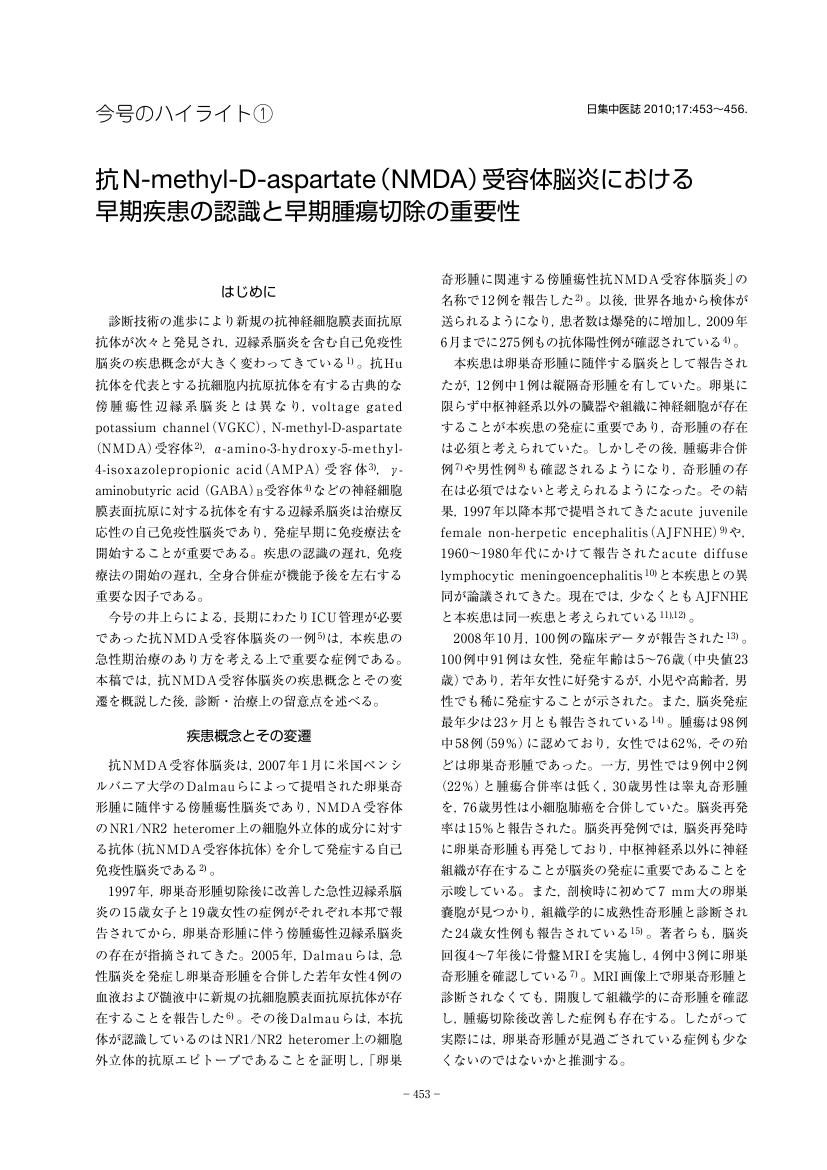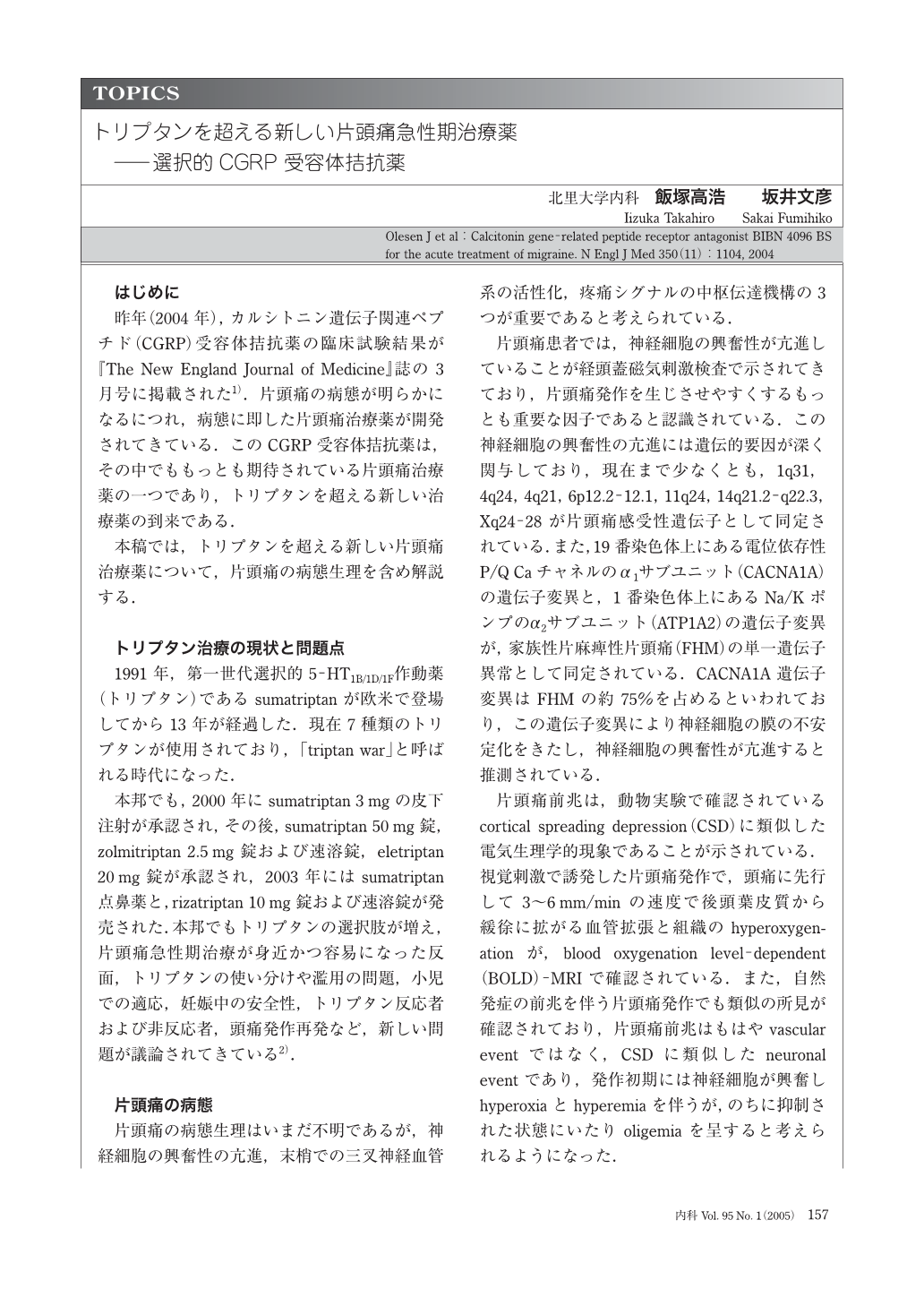40 0 0 0 OA 教育講演2 抗NMDA受容体抗体脳炎の臨床と病態
- 著者
- 飯塚 高浩
- 出版者
- 日本神経学会
- 雑誌
- 臨床神経学 (ISSN:0009918X)
- 巻号頁・発行日
- vol.49, no.11, pp.774-778, 2009 (Released:2009-12-28)
- 参考文献数
- 10
- 被引用文献数
- 4 3
Recently a new category of treatment-responsive encephalitis has been proposed associated with antibodies against neuronal cell membrane antigens, including VGKC, NMDA receptor (NMDAR) and AMPA receptor. Anti-NMDAR encephalitis is caused by the antibodies, which bind to extracellular conformal epitope in the NR1/NR2 heteromers of the NMDAR. The antibodies are usually detected in CSF/serum of young women with ovarian teratoma (OT), who typically developed schizophrenia-like psychiatric symptoms. Most patients developed seizures, followed by unresponsive/catatonic state, central hypoventilation, and bizarre orofacial-limb dyskinesias. Based on symptomatology and current NMDAR hypofunction hypothesis in schizophrenia, we speculated that the antibodies might cause inhibition of NMDAR in presynaptic GABAergic interneurons, causing a reduction of release of GABA. This results in disinhibition of postsynaptic glutamatergic transmission, excessive release of glutamate in the prefrontal/subcortical structures, and glutamate/dopamine dysregulation. Recent studies demonstrated that the antibodies cause reversible reduction in the numbers of cell-surface NMDAR and NMDAR clusters in postsynaptic dendrites, suggesting antibodies-mediated decreased function of NMDAR. Early tumor resection with immunotherapy is recommended in OT-positive cases but not in OT-negative cases. However, exploratory laparotomy may increase the chance to identify microscopic teratoma and improve the outcome if patients who were refractory to immunotherapy had anti-NMDAR antibodies and ovarian cyst.
18 0 0 0 OA 自己免疫性脳炎およびその類縁疾患における最近の進歩
- 著者
- 飯塚 高浩
- 出版者
- 日本神経学会
- 雑誌
- 臨床神経学 (ISSN:0009918X)
- 巻号頁・発行日
- vol.59, no.8, pp.491-501, 2019 (Released:2019-08-29)
- 参考文献数
- 68
- 被引用文献数
- 4
一連の抗神経細胞表面抗原抗体の発見により,脳炎自体の疾患概念も10年で大きく変化し,「自己免疫性脳炎(autoimmune encephalitis; AE)の診断に対する臨床的アプローチ」が提唱された.現在では,脳炎・脱髄重複症候群,てんかん,精神症状,異常運動,単純ヘルペス後脳炎,stiff-person症候群あるいは睡眠行動異常症の一部にもこれらの抗体が関与していることが示され,疾患の既成概念や画像所見にとらわれることなく,早期診断・早期治療することが求められる時代になった.AEの診断・治療上,本邦においては解決すべき課題は沢山あるが,本稿では,橋本脳症や新規発症難治性てんかん重積も含め,実臨床に関連のある話題に焦点を絞って述べる.
12 0 0 0 OA 内科診療に潜む脳症・脳炎を見落とさないために
- 著者
- 髙嶋 博 桑原 聡 栗山 勝 飯塚 高浩
- 出版者
- 一般社団法人 日本内科学会
- 雑誌
- 日本内科学会雑誌 (ISSN:00215384)
- 巻号頁・発行日
- vol.106, no.8, pp.1598-1610, 2017-08-10 (Released:2018-08-10)
- 著者
- 飯塚 高浩
- 出版者
- 一般社団法人 日本集中治療医学会
- 雑誌
- 日本集中治療医学会雑誌 (ISSN:13407988)
- 巻号頁・発行日
- vol.17, no.4, pp.453-456, 2010-10-01 (Released:2011-04-30)
- 参考文献数
- 19
3 0 0 0 OA 自己免疫性脳炎における早期診断と早期治療の重要性
- 著者
- 飯塚 高浩
- 出版者
- 日本神経治療学会
- 雑誌
- 神経治療学 (ISSN:09168443)
- 巻号頁・発行日
- vol.35, no.3, pp.231-236, 2018 (Released:2018-12-25)
- 参考文献数
- 24
After the discovery of new class of autoantibodies against neuronal cell surface antigens and synaptic proteins (NSA–antibodies), the concept of encephalitis has dramatically changed. Encephalitis can be divided into infectious and autoimmune (non–infectious) groups. Autoimmune encephalitis (AE) may have autoantibodies against intracellular onconeuronal antigens (e.g. Hu, Yo, Ri, CV2/CRMP5, Ma2, amphiphysin) or NSA (e.g. NMDAR, AMAPAR, GABAaR, GABAbR, DPPX). Most of the former antibodies are not pathogenic but are used as a biomarker of classical paraneoplastic neurological syndromes, whereas IgG NSA–antibodies are more likely pathogenic, and the presence of the antibodies implies that patients may respond to immunotherapy. With infectious etiologies in mind previous diagnostic criteria for encephalitis has been made based on fever, mental status changes, inflammatory CSF, and brain MRI and EEG abnormalities ; however, these abnormalities may not be present in patients with NSA antibody–positive AE. Although early initiation of immunotherapy is often emphasized in AE, antibody testing is not readily accessible in most situation, thus initiation of immunotherapy may be delayed. Therefore, in 2016, a practical diagnostic approach to AE was proposed to achieve prompt immunotherapy at 3 levels of evidence for AE (possible, probable, and definite) with several new diagnostic criteria. A recent study showed that diffuse brain atrophy in anti–NMDAR encephalitis can be reversible and does not imply a poor clinical outcome. In contrast, cerebellar atrophy was irreversible and associated with a poor outcome. First–line immunotherapy can be started depending on the severity of patients with possible AE at early stage while excluding alternative diagnosis, but the second–line immunotherapy should be carefully used after confirming the NMDAR–antibodies in CSF with appropriate testing.In this lecture, I focus on anti–NMDAR encephalitis and talk about a potential pitfall in clinical diagnosis of the disease.
2 0 0 0 OA 自己免疫脳炎と自己抗体に関する豆知識
- 著者
- 飯塚 高浩
- 出版者
- 日本神経治療学会
- 雑誌
- 神経治療学 (ISSN:09168443)
- 巻号頁・発行日
- vol.36, no.4, pp.388-394, 2019 (Released:2020-04-24)
- 参考文献数
- 29
After the discovery of new class of autoantibodies against neuronal cell surface antigens or synaptic proteins (NSA), the concept of acute encephalitis has dramatically changed. Encephalitis can be divided into infectious and autoimmune encephalitis (AE). AE may have autoantibodies against intracellular onconeuronal antigens (e.g. Hu, Yo, Ri, CRMP5, Ma2), intracellular synaptic proteins (e.g. amphiphysin, GAD65) or NSA (e.g. NMDAR, AMAPAR, GABAaR, GABAbR, LGI1, Caspr2, DPPX).Most of the classic paraneoplastic anti–neuronal antibodies are less likely pathogenic but IgG NSA antibodies are more likely pathogenic, and the presence of the NSA antibodies implies that patients may respond to immunotherapy. Although early initiation of immunotherapy is often emphasized in AE, antibody testing is not readily accessible in most situation, thus initiation of immunotherapy may be delayed. In 2016, a practical diagnostic approach to AE was published as a position paper in Lancet Neurology to achieve prompt immunotherapy at 3 levels of evidence for AE (possible, probable, and definite) with several new diagnostic criteria including possible AE, probable AE, probable and definite anti–NMDAR encephalitis, autoimmune limbic encephalitis, ADEM, and Hashimoto encephalopathy.In this lecture, I focus on recent progress in antibody–mediated encephalitis, stiff–person spectrum disorder, and cryptogenic new–onset refractory status epilepticus (C–NORSE) with development of a clinically–based score that predicts C–NORSE.
1 0 0 0 OA 自己免疫性脳炎およびその類縁疾患におけるUp to Date
- 著者
- 飯塚 高浩
- 出版者
- 日本神経治療学会
- 雑誌
- 神経治療学 (ISSN:09168443)
- 巻号頁・発行日
- vol.38, no.3, pp.155-163, 2021 (Released:2022-01-19)
- 参考文献数
- 49
It has been demonstrated that neuronal surface (NS) antibodies play an important role in the pathophysiology of various neurological and neuropsychiatric disorders, including non–infectious/post–infectious encephalitis, first–episode psychosis, epileptic and non–epileptic seizures, atypical demyelinating syndrome, post–partum psychosis, progressive dementia, involuntary movements (orofacial–limb dyskinesias, faciobrachial dystonic seizures, catatonia, rigidity, stiffness, tremors, myoclonus, chorea, stereotypies, oculomotor abnormalities), and non–REM/REM sleep disorder. IgG NS antibodies are considered more likely to be pathogenic, accordingly the presence of NS antibodies supports early initiation of immunotherapy. In 2016, a practical diagnostic approach to autoimmune encephalitis (AE) was proposed to achieve prompt immunotherapy at 3 levels of evidence for AE (possible, probable, and definite) with diagnostic criteria for possible AE, probable AE, probable and definite anti–NMDAR encephalitis, autoimmune limbic encephalitis, ADEM, and Hashimoto encephalopathy. Identification of autoantibodies against NS or intracellular antigens is crucial in making a diagnosis ; however, the antibody testing results should be carefully assessed especially when measured with commercial assay alone.In this lecture, I focus on recent progress in AE, and its related disorder including cryptogenic new–onset refractory status epilepticus.
1 0 0 0 OA 抗glycine受容体抗体陽性のstiff-limb症候群の1例
- 著者
- 前田 憲吾 清水 芳樹 杉原 芳子 金澤 直美 飯塚 高浩
- 出版者
- 日本神経学会
- 雑誌
- 臨床神経学 (ISSN:0009918X)
- 巻号頁・発行日
- pp.cn-001239, (Released:2019-01-31)
- 参考文献数
- 9
- 被引用文献数
- 2 1
症例は48歳女性.43歳時に下肢硬直感が出現したが3か月で自然軽快した.両下肢の筋硬直が再発し,ミオクローヌスが出現し入院.意識清明,言語・脳神経は異常なし.両足趾は背屈位で,足関節は自他動で動かないほど硬直していた.神経伝導検査は異常なく,針筋電図では前脛骨筋に持続性筋収縮を認めた.血液・髄液一般検査は正常で,抗GAD65抗体・抗VGKC複合体抗体は陰性.脊髄MRIにも異常なく,症候学的にstiff-limb症候群(SLS)と考え,ステロイドパルス療法を実施し筋強直は改善した.その後,血液・髄液の抗glycine受容体抗体が陽性と判明した.プレドニゾロン内服後,再発はない.
1 0 0 0 OA 抗glycine受容体抗体陽性のstiff-limb症候群の1例
- 著者
- 前田 憲吾 清水 芳樹 杉原 芳子 金澤 直美 飯塚 高浩
- 出版者
- 日本神経学会
- 雑誌
- 臨床神経学 (ISSN:0009918X)
- 巻号頁・発行日
- vol.59, no.2, pp.98-101, 2019 (Released:2019-02-23)
- 参考文献数
- 9
- 被引用文献数
- 2 1
症例は48歳女性.43歳時に下肢硬直感が出現したが3か月で自然軽快した.両下肢の筋硬直が再発し,ミオクローヌスが出現し入院.意識清明,言語・脳神経は異常なし.両足趾は背屈位で,足関節は自他動で動かないほど硬直していた.神経伝導検査は異常なく,針筋電図では前脛骨筋に持続性筋収縮を認めた.血液・髄液一般検査は正常で,抗GAD65抗体・抗VGKC複合体抗体は陰性.脊髄MRIにも異常なく,症候学的にstiff-limb症候群(SLS)と考え,ステロイドパルス療法を実施し筋強直は改善した.その後,血液・髄液の抗glycine受容体抗体が陽性と判明した.プレドニゾロン内服後,再発はない.
- 著者
- 飯塚 高浩 坂井 文彦
- 出版者
- 南江堂
- 雑誌
- 臨床雑誌内科 (ISSN:00221961)
- 巻号頁・発行日
- vol.95, no.1, pp.157-160, 2005-01-01
1 0 0 0 OA 抗NMDA受容体脳炎の臨床像と治療戦略
- 著者
- 飯塚 高浩
- 出版者
- 一般社団法人 日本小児神経学会
- 雑誌
- 脳と発達 (ISSN:00290831)
- 巻号頁・発行日
- vol.45, no.2, pp.115-120, 2013 (Released:2014-10-11)
- 参考文献数
- 20
抗NMDA受容体脳炎は, NR1 subunitの細胞外成分に対する抗体を有する脳炎である. 腫瘍は全体の39%に認め, 12歳以降の女子では54%と半数以上に腫瘍を認め, そのほとんどは卵巣奇形腫である. 典型例では, 感冒症状に引き続く著明な精神症状で発症し, けいれん, 無反応, 低換気, 不随意運動および自律神経症状が数カ月~1年以上持続する. シナプス後膜NMDA受容体数が減少し, 精神神経症状が発現する. ステロイドパルス, 免疫グロブリン大量療法および血漿交換が第1選択治療であるが, 難治例ではrituximabやcyclophosphamide大量療法を用いる. 腫瘍随伴例では早期腫瘍切除と免疫療法が推奨されている.
1 0 0 0 降圧薬の投与開始後,短期間のうちに発症した脳梗塞についての検討
- 著者
- 飯塚 高浩 神田 直 稲福 徹也 畑 隆志 坂井 文彦
- 出版者
- The Japan Stroke Society
- 雑誌
- 脳卒中 (ISSN:09120726)
- 巻号頁・発行日
- vol.16, no.4, pp.239-243, 1994
降圧薬の投与開始後短期間のうちに発症した脳梗塞について検討した.対象は降圧薬の服用開始後1ヵ月以内に発症した脳梗塞9例であり, 年齢は48歳から83歳, 平均66.7±10.5歳である.服用開始後発症までの期間は, 5例が7日未満であり, 平均10.1±8.6日.基礎疾患は高血圧に加え, 4例で糖尿病, 1例で心房細動を認めた.1例を除き全例初回発作であった.降圧薬の種類はCa拮抗薬が8例と最も多く, うち4例はβ遮断薬, ACE阻害薬など2種以上の降圧薬を初回より併用し, 1例は3剤同時開始例であった.また1例は単剤ではあるが高齢者に対して初回より常用最上限が投与され翌日の発症であった.責任病巣は, 放線冠など穿通枝領域が6例と最も多く, 皮質枝領域が2例, 境界領域が1例であった.機能予後は, 7例は独歩, 2例は車椅子であった.降圧薬の投与に際しては, 投与量に留意し, 原則として, 単剤, 少量から開始すべきであると考える.
1 0 0 0 OA シンポジウム3―2 抗NMDA受容体抗体陽性脳症 抗NMDA受容体脳炎の臨床と病態
- 著者
- 飯塚 高浩
- 出版者
- 日本神経学会
- 雑誌
- 臨床神経学 (ISSN:0009918X)
- 巻号頁・発行日
- vol.48, no.11, pp.920-922, 2008 (Released:2009-01-15)
- 参考文献数
- 10
- 被引用文献数
- 4 3
Anti-N-methyl-D-aspartate receptor (NMDAR) encephalitis is a new category of treatment-responsive encephalitis associated with "anti-NMDAR antibodies," which bind to extracellular conformal epitope in the NR1/NR2 heteromers of the NMDAR. The antibodies are usually detected in CSF/serum of young women with ovarian teratoma, who typically developed schizophrenia-like psychiatric symptoms, usually preceded by viral infection-like illness. Most cases developed seizures, followed by unresponsive/catatonic state, decreased level of consciousness, central hypoventilation, orofacial-limb dyskinesias, and autonomic symptoms. Brain MRI is often unremarkable. CSF reveals nonspecific changes. EEG shows diffuse delta slowing. The pathogenesis remains unknown, however this disorder is considered as an antibodies-mediated encephalitis. The prodromal"viral-like"disorder by itself or in combination with a teratoma sets off the autoimmune response. The antibodies bind to the common autoantigens expressed on the cell membrane of the neurons in the forebrain/hippocampus. Based on the current NMDAR hypofunction hypothesis of schizophrenia, we speculate that the antibodies may cause inhibition of NMDAR, rather than stimulation, in presynaptic GABAergic interneurons, causing a reduction of release of GABA. This results in disinhibition of postsynaptic glutamatergic transmission, excessive release of glutamate in the prefrontal/subcortical structures, and glutamate and dopamine dysregulation that might contribute to development of schizophrenia-like psychosis and bizarre dyskinesias.


